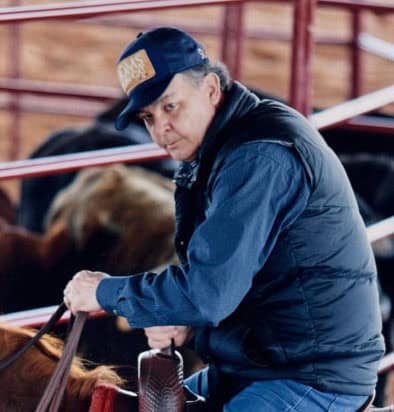BY SARAH WELK BAYNUM
Sergio Armelin Ramos may be new to Ocala and Thoroughbred racing, but he is no stranger to the sport of horse racing. He is a generational horseman who spent most of his life running a large-scale horse business in Brazil.
“I got started in the horse business at a very young age—my grandfather bred horses more than fifty years ago,” Sergio Armelin Ramos said. “My best memories with horses come from working alongside my grandfather on his ranch. At that time, American Quarter Horses were used in a variety of sports and many had significant Thoroughbred bloodlines. In Brazil, we have a strong tradition of horse auctions and have bred champions in various disciplines, including racing, cutting and roping. We also had several ranches in different states, including Mato Grosso do Sul, which is more of a racing state.”
Ramos decided to continue his grandfather’s legacy after his passing.
“I bought good American horses, mostly importing Quarter Horse mares from Texas. We used embryo transfer to accelerate the breeding process. I was fortunate to purchase an excellent horse from there, named Laredo Blue, who has won over $300,000 in cutting competitions. He was very famous because Buffalo Ranch owned him and some of the best riders competed with him—that helped build our farm’s reputation.”
Some of Ramos’s most notable mares include Xeroquee Apollitical, by Apollitical Jess; and Chanel Eagle, by One Famous Eagle. While Thoroughbred racing is more popular than Quarter Horse racing in the United States, the opposite is true in Brazil for several reasons.
“Quarter Horse racing in Brazil is very exciting, with shorter races that draw crowds,” Ramos said. “Unlike in the U.S., people in this region often carry cash and place bets in person—a cultural tradition that persists. Sorocaba, in São Paulo state, is home to a famous racetrack, and another, located near my ranch in Ponta Porã, attracts many bettors from Paraguay.
Quarter Horse racing has also surpassed Thoroughbred racing in popularity in Brazil due to lower track maintenance costs and a breeding history that favors sprinters over distance runners. The speed and excitement of horse racing have intrigued me from a young age. Watching yearlings begin their training and develop into winners is the most rewarding gift of all. It’s what I love most about the horse racing industry.”
While Ramos recently relocated to Ocala, this is not his first time living in the United States or visiting the Horse Capital of the World®.
“I have fond memories of my time as a Rotary Club exchange student in Phoenix, Arizona, in 1986—that’s when I fell in love with the United States and its horse industry,” Ramos said. “I first came to Ocala in 2008 when I attended the Sun ‘n Fun Expo in Lakeland. I’ve always loved aviation—I’m also a pilot and I used to fly between my ranches in Brazil because the roads were terrible—and traveling by plane saved a lot of time.
“A friend invited me to visit Ocala, and it was then that I began learning about the city’s horse industry. I discovered that Ocala has over 1,200 horse farms and the facilities are excellent. While Brazil has produced many great racehorses, in my opinion, past legends such as Secretariat, Beduíno and Dash for Cash have made an incredible impact on the sport.
“I’ve admired the U.S. since I was an exchange student and believe it produces some of the world’s finest horses. Top stallions stand here and importing American mares to Brazil is too costly. Brazil’s struggling economy and high taxes made it difficult for business owners, so I sought a fresh start in a stronger horse industry.”
While Ramos is eager to get his new Thoroughbred racing business started in Ocala, he first wants to ensure that he sets himself up for success.
“Since arriving, I’ve immersed myself in the Thoroughbred industry—attending an OBS auction, visiting Gulfstream Park and Tampa Bay Downs and joining the Florida Thoroughbred Breeders’ and Owners’ Association. Tammy Gantt of the FTBOA has introduced me to some key people and I’ve learned the importance of making the right connections.
“Currently, I’m not investing in Thoroughbreds yet—I want to understand the business fully first. I’m considering an online course from the University of Louisville, where I will study pedigrees, auction results and various aspects of the industry, including breeding, buying, selling, and training. My background is in Quarter Horse breeding, but I need to learn the specifics of Thoroughbred racing before making major investments.”
Despite being a newcomer to America’s Thoroughbred racing, he is already thinking about the next generation of horsemen and how he can help preserve the sport of horse racing.
“I hope to inspire more young people to get involved with horses, whether through school programs or hands-on experiences, to preserve this beautiful way of life,” Ramos said. “In Brazil, we have programs that allow children to interact with horses as part of their rehabilitation and therapy. Perhaps I can help create something similar here, collaborating with associations to bring students to ranches and provide them with hands-on experience. If they don’t grow up with horses, how will they have the option to continue this business? We need the next generation to be involved. It would be a way to inspire young people and ensure the future of horse racing.”
“I am genuinely excited to be in Florida—it already feels like home,” Ramos added. “The Florida horse community has been so welcoming, the facilities are world-class, and the business opportunities are endless. Like in Brazil, my goal in the U.S. is to breed top racehorses and prepare outstanding yearlings for the market. I look forward to meeting and collaborating with even more Thoroughbred industry members and trainers to exchange knowledge and experiences.”
Return to the April 8 issue of Wire to Wire
